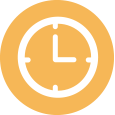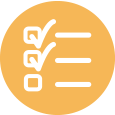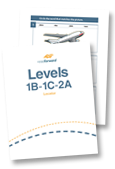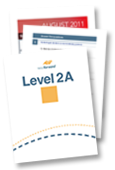The purpose of the User Guide is to help adult literacy practitioners (i.e., educators, coordinators, instructors, tutors) know how to correctly select a test, how to prepare and administer it, and how to mark it and give learners feedback about test scores and reading skills and strategies. It provides general directions for each of these steps, as well as instructions that are specific to and complete for each of the six levels (although there are similarities across the six levels, there are also differences).
Users of Read Forward are encouraged to take the time to read through the User Guide for How Read Forward Works and How to Use Each Level to understand the steps and get the best results in using this adult reading assessment resource.

Select a Level
It is important to select a test from a level that has a high probability of success for each learner. This is preferable to selecting a test from a level that may be too difficult, which may increase anxiety about taking tests. Relate what you know about the learner’s reading skills to Read Forward’s Reading Skills table that lists the reading skills used in each level and/or use Read Forward’s locator tests.
Locator Tests
Read Forward has two locator tests that will help you determine which level is the best starting place for a learner new to the Read Forward tests. The first locator test is for lower reading skills and includes questions and texts that correlate to Levels 1B, 1C and 2A. The second includes questions and texts with difficulty that correlates to Levels 2A, 2B, 2C and 3A. There are answer keys to mark the tests and score sheets that allow you to easily see where to start each learner. (See pages 20-21 of the User Guide for specific instructions on how to use Locator Tests.)
The Tests
After determining where to start a learner, select a test from the appropriate level. Read Forward has six levels, based on successive reading skill development. The tests in each level contain questions that relate to that particular level of reading skills. There are five tests in each level (identified by the symbols ![]() ;
; ![]() ;
; ![]() ;
; ![]() ;
; ![]() ), each of which is different from the others in content, but equal to them in difficulty. The tests use familiar texts that reflect where every day reading takes place: in the home, the community and the workplace. Tests include prose and document texts. The tests allow practitioners and learners to assess competency in reading skills and determine reading strategies that will help them progress in reading skills.
), each of which is different from the others in content, but equal to them in difficulty. The tests use familiar texts that reflect where every day reading takes place: in the home, the community and the workplace. Tests include prose and document texts. The tests allow practitioners and learners to assess competency in reading skills and determine reading strategies that will help them progress in reading skills.

Prepare for the Test
First take some time to review the test so that you understand its format and purpose. Second, find the answer key for that specific test to see how learners should answer the test questions. Third, review the reading skills of the specific level to understand the reading tasks learners will be required to perform on the test.
Having a discussion about the Read Forward tests prior to administering them helps learners to better understand the purpose of testing reading and reduces their concerns about taking the test.
- Inform learners that Read Forward tests will help them better understand their reading skills because the results will show what they can already do and what reading skills they can improve.
- Explain that the examples used in the text imitate everyday reading tasks and so the tests are different from tests on a specific subject of study or course content.
- Describe the unique layout of the test. From a different test than the one that the learners will write, you can show an example of a question and text, to help them understand the unique layout.
- Explain the marking format that Read Forward uses, which might be different than what the learner has encountered before. These tests are not about passing or failing but instead test scores help learners think about reading skills and strategies.

Administer the Test
Support learners by ensuring that the learning environment is conducive to writing tests.
Show the learners the layout of the test. Instruct learners to read the questions before reading the text, and then to look to the text for the information they need to answer the questions. All questions are short answer, requiring the reader to write directly on the text or on line(s) following the question or below the question. Their responses can vary from one word to a few sentences, depending on the test level being used. Let them know that spelling and grammar will not be marked, that each question is worth one mark and that there are no partial marks.
Although Read Forward does not prescribe a time limit for writing the tests, the tests were designed to be written in one hour or less.

Mark the Test
Answer keys, which include questions, complete answers and reading skills required to answer the questions, are provided to facilitate marking the tests and providing results feedback.
There are some specific considerations when it comes to marking.
- The answer key represents the optimal answer. Possible alternate answers are indicated and optional information is included.
- There are no partial marks. Each question is worth one full mark and is scored as either correct or incorrect. Each question is designed for specific skills and by only providing part of the answer the learner may only be demonstrating reading skill competency that correlates to a prior test level.
- This resource is designed to assess reading only and not writing. This means that learners do not have to use complete sentences to answer questions and that errors in spelling and grammar do not result in a loss of a mark.
- For tests from Levels 1B, C, 2A and 2B, the learner will have a total score out of 30 marks, and for Levels 2C and 3A, out of 20 marks.
Once you have marked the tests, convert the number score into a percentage and place it on the scale on the results feedback form for that specific level. Learners’ scores will determine if they will continue in a particular level, move to a previous level or move onto the next level.

Provide Feedback to the Learner
Providing feedback is crucial to reading development. Read Forward’s results feedback form is the way to make the connection between a test score, reading skills and reading strategies.
There is a results feedback form for each test level. It has two parts. The scale score helps learners see their progression through each level, rather than focusing on moving from one level to another. The other part, called “What to work on,” provides space to highlight the skills being tested, what the learner has accomplished, and what reading strategies can help to improve reading skills and progress in reading abilities.
Use a results feedback form with every Read Forward test each learner takes. Take the time to go over the results feedback form with learners.


